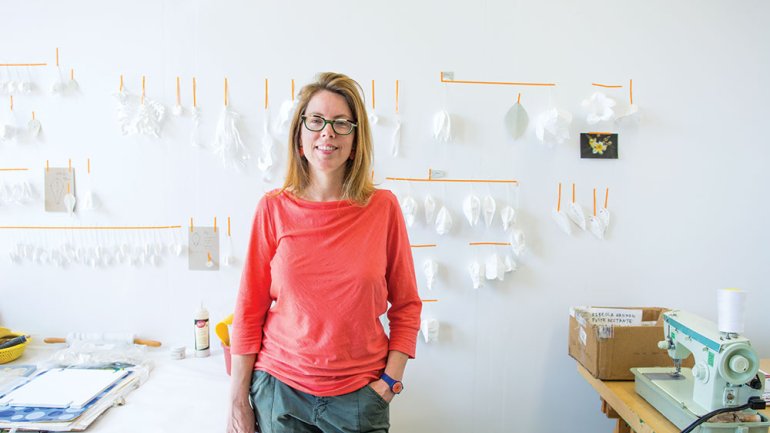Art of Reinvention
Art of Reinvention
“I feel like every five years I do something different,” says Rebecca Hannon. The jewelry artist has uprooted herself according to this schedule for the past two decades, hauling heavy boxes of art books and bags full of jewelry supplies across oceans and continents.
The cool part for jewelry lovers and collectors? Hannon’s work bears witness to these many moves. Hannon is better known as an experimental artist, one who works with an ever-evolving cast of nontraditional materials. But it’s easy to fall in love with her work’s narrative qualities, serving as a material record of her changing perspectives as she pursues the life of an artist.
Hannon started her five-year habit quite by accident, after graduating from Rhode Island School of Design in 1995. She spent the next half-decade living in New York City, where she worked for high-carat goldsmiths like Reinstein/Ross and Samuel Beizer, hand-fabricating finery for Tiffany’s and other luxury retailers. “It wasn’t conceptual at all,” she says. “It was just great training, to work professionally and learn about the trade.”
But after five years, she was ready to move on. “It felt risky to leave my NYC life behind – but it was the right time,” she says. Next up was graduate school at the Akademie der Bildenden Künste in Munich, home to one of the world’s most innovative jewelry programs. “Munich is this bubble of creativity,” Hannon says. “The best jewelers in the world live there.” She absorbed their influence, especially the New Zealander Lisa Walker, known for wild assemblages of found objects, and Aussie Helen Britton, who makes amoebic brooches and collage-like chain necklaces using plastics, electrical wire, the occasional precious stone, and lots of paint.
There were inklings of Hannon’s bent toward the alternative long before Munich. As an ace high school art student in the Washington, DC, suburb of Reston, Virginia, she had discovered a cache of books featuring the work of Hermann Jünger, an avant-garde German metalsmith who taught at the Akademie for decades. (Alas, Jünger retired before Hannon’s arrival.) “These books completely compelled me,” Hannon recalls. “I even hand-copied the books into my journal because I thought I’ll never see something so fabulous again.”
In Germany, Hannon was free to follow in Jünger’s footsteps, to explore her far-out interests. She started by biking around Munich, like a tourist in her new city, snapping photographs of baroque churches and other buildings that caught her eye. She would later clip these images into fragments, arranging them into hexagonal shapes, the beginning of her Photo series of brooches. “It turned out if you had doubles and overlaid the gingerbread rooftops, you made this fancy gem,” she explains.
From this point forward, each new series looks nothing like its predecessor, as if each were created by a different artist. While living in Munich, Hannon undertook a 40-day journey along the Camino de Santiago, an ancient Christian pilgrimage route bisecting northern Spain. Along the way, she collected a distinct wildflower, plant, or leaf every day, pressing them in her journal. Then she used the silhouettes for a series of neckpieces and earrings made mainly from rubber and latex, with bright bursts of color. Romantic and lush, with a distinct note of cheer, the Camino series marks more than an aesthetic shift: Hannon met her husband, Anton Christiansen, an American architect, while making the 500-mile trek.
She also began exploring in earnest the many unusual and non-precious materials that now characterize her work. “I started doing these different material experiments and slowly finding my voice.”
Recently, she became fascinated with Keraflex, a paper-thin porcelain. “I gave myself a year to not think about jewelry at all, just to get to know that material, to learn its strengths and weaknesses,” she says.
“Rebecca finds a concept and then she finds the appropriate material,” observes Ellen Reiben, owner of Jewelerswerk Galerie in Washington, DC, where Hannon enjoys a healthy following. Hannon constantly challenges herself to learn new materials, because she’s constantly hunting for the next medium to express her ideas and tell her life stories.
Case in point: Hannon and Christiansen, newly married, moved to Ithaca, New York, in 2005. “It was really a place with long winters and a lot of inside time,” explains Hannon. The resulting Nest series relies on blackened silver plus the occasional found object (ladyfinger tins, goose-egg shells) strung together with dark pieces of horsehair. The horsehairs are “kind of like a vector drawing,” she says. “They’re really uneven, and they’re really strong.”
In 2009 Hannon accepted a teaching position at the Nova Scotia College of Art and Design University, and her work shifted yet again. “Now that I live in Halifax the work is brightly colored, almost formal compositions,” she says, noting all the area fishing shacks splashed with primary colors. Her latest Laminate series features rounded pieces of Formica in vivid shades, arranged into 3D earrings, brooches, and, most covetable of all, a series of chunky necklaces that bring to mind the playful work by surrealist Joan Miró.
“Her photograph brooches were beautiful, but they were much more introspective,” says Stefan Friedemann, co-owner of Ornamentum in Hudson, New York. The Formica collection is festive, hinting at Hannon’s current mood: She’s happy in Halifax. She likes teaching. She enjoys the local arts community, which is fortified with university graduates.
Next year her five years are up in Halifax. But, for the first time in a long time, she has no plans to leave.
Christy DeSmith is a Minneapolis-based writer. She covers the arts, culture, and travel.




